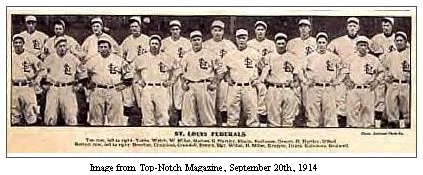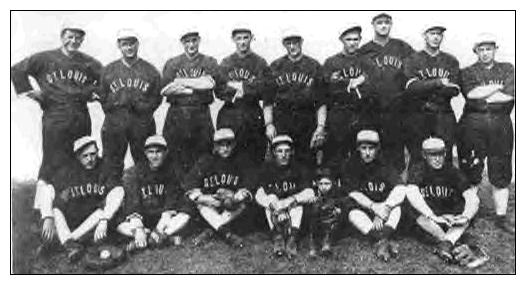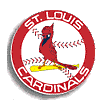
St. Louis Terriers
Federal League (1914-1915)
Roster
On March 8th, 1913, the Federal League was
organized as a six-team minor league operating outside the bounds of organized baseball
at that time, with franchises in St Louis, Chicago, Cleveland, Pittsburgh, Indianapolis,
and Cincinnati. The exisiting major leagues (the American and National Leagues)
and Organized Baseball as a whole paid little attention to the new league, thinking
it would wither like previous leagues which had tried to outside the bounds of
organized baseball. The 1913 Terriers finished that season at 59-60, in third place, 15
games behind the Indianapolis club and 4 1/2 games behind second place Cleveland.
Before the start of the 1914 season, the Federal League declared itself a major
league and expanded to eight teams (dropping the franchise from Cleveland and putting
clubs in Buffalo, Brooklyn and Baltimore to establish an East Coast presence). In the
midst of this reorganization, the league enticed new investors to join in. Among these
were Otto Steifel, a St. Louis banker and brewer, and Philip De Catesby Ball, who made
his money selling ice in St. Louis.
While the Federal League announced it would not pursue players under contract with AL
or NL clubs, it almost immediately turned around and signed George Stovall of the
 St. Louis Browns to manage the club in Kansas City for the 1914 season. (This club,
which started the 1913 season in Cincinnati, moved to KC midway through the summer.)
Stoval was player-manager for the Browns in 1913, but had some disputes with the
owner during the summer, and was all but fired before the season ended. However, the
Brown's owner refused to release Stovall, so he welcomed the opportunity to jump
ship to the new league. Stovall was the first of many; during the two years of the
Federal League, 81 major leaguers switched to the new league, along with another 140
minor leaguers. Most noteable, however, was one player who almost jumped but didn't
- Walter Johnson. Upset at the contract offered him by Washington for the 1915 season,
Johnson signed with the Chicago Whales for the 1915 season for a raise plus a $6000
signing bonus. However, shortly after signing, he backed out on his Federal League
contract to go back to Washington. Charles Comiskey, owner of the Chicago White Sox,
was concerned about the cross-town competition and agreed to repay the signing bonus
given to Johnson in order to facilitate his return to the American League.
St. Louis Browns to manage the club in Kansas City for the 1914 season. (This club,
which started the 1913 season in Cincinnati, moved to KC midway through the summer.)
Stoval was player-manager for the Browns in 1913, but had some disputes with the
owner during the summer, and was all but fired before the season ended. However, the
Brown's owner refused to release Stovall, so he welcomed the opportunity to jump
ship to the new league. Stovall was the first of many; during the two years of the
Federal League, 81 major leaguers switched to the new league, along with another 140
minor leaguers. Most noteable, however, was one player who almost jumped but didn't
- Walter Johnson. Upset at the contract offered him by Washington for the 1915 season,
Johnson signed with the Chicago Whales for the 1915 season for a raise plus a $6000
signing bonus. However, shortly after signing, he backed out on his Federal League
contract to go back to Washington. Charles Comiskey, owner of the Chicago White Sox,
was concerned about the cross-town competition and agreed to repay the signing bonus
given to Johnson in order to facilitate his return to the American League.
For the 1914 season, the Terriers signed Mordecai "Three-Finger" Brown, a premier
pitcher with the Chicago Cubs from 1904 to 1912. Brown was at the tail end of a
Hall of Fame career that started with the St. Louis Cardinals in 1903. He had won 20
or more games with the Cubs from 1906 to 1911, but had managed only an 11-12 record
in 1913 with the Cincinnati Reds. Brown, Doc Crandall from the Giants, and former
20 game winner Bob Groom from Washington were expected to provide the Terriers with
a top pitching staff. The club started out with a 10-3 record, including an 8 game
winning streak, to take an early lead in the standings. However, they dropped as
the season progressed. Groom lost twenty games while winning only thirteen. Brown,
their manager, went 12-6 for the Terriers, but was traded to the Federal League's
Brooklyn club as the team continued to do poorly. Fielder Jones, manager of the Cubs
from 1904-1908, took over the club on August 22, 1914; he managed in 1915 as well. The
Terriers won only 62 games while losing 89 and finished last, 25 games behind the
Indianapolis Hoosiers. (Despite winning the pennant, the Hoosiers franchise moved
to Newark for the 1915 season.)
Prior to the 1915 season, the Terriers added Eddie Plank, another future Hall of Famer,
who came over from the White Sox of the American League. Plank won 21 games. One of those
wins was his 300th win, on September 11, 1915 at Handlan Park in St. Louis. Two
 other Terrier pitchers, Dave Davenport (22-18) and Doc Crandall (21-15) also topped
twenty wins. The Terriers moved up from fifth place in August into a three-way race for
the pennant with the Chicago Whales and the Pittsburgh Rebels as the season wound down.
When the dust settled, the Terriers placed second. The Whales, having played two less
games, finished at 86-66 (0.566) while the Terriers finished at 87-67, (0.565) in second
place by 0.001 percentage points. Pittsburgh finished in third at 86-67 (0.562), one-half
game back of the two leaders. The second and final Federal League pennant race remains
the closet margin of victory in professional sports.
other Terrier pitchers, Dave Davenport (22-18) and Doc Crandall (21-15) also topped
twenty wins. The Terriers moved up from fifth place in August into a three-way race for
the pennant with the Chicago Whales and the Pittsburgh Rebels as the season wound down.
When the dust settled, the Terriers placed second. The Whales, having played two less
games, finished at 86-66 (0.566) while the Terriers finished at 87-67, (0.565) in second
place by 0.001 percentage points. Pittsburgh finished in third at 86-67 (0.562), one-half
game back of the two leaders. The second and final Federal League pennant race remains
the closet margin of victory in professional sports.
While the Terriers were competative at the gate with their NL and AL rivals, the league
as a whole wasn't as successful. Legal battles with the two other leagues drained the
financial life out of the Federal League clubs. The maneuvering between the leagues
culminated when the Federal League filed an anti-trust suit against the other two
leagues after the 1914 season. The suit landed in the court of Judge Kenesaw Mountain
Landis. Landis was considered tough on monopolies and this looked good for the new
league. However, he postponed his decision in the case, and time ran out for the
Federals. After the 1915 season, the league worked out an agreement with the National
and American Leagues for the dispersement of its players. Phil Ball, owner of the
Terriers, purchased the St. Louis Browns as part of the deal, and Charles Wheegman
purchased the Chicago Cubs. (Wheegman moved the Cubs into Wheegman Park, built before
the 1914 season for the Chicago Whales. Wheegman Park is still in use today under
the name Wrigley Field.) The rest of the teams were allowed to sell off their players
to recoup their losses, and the Federal League closed its doors for good. The owners
of the Baltimore franchise in the Federal League refused to go quietly, and pursued
the anti-trust suit against the majors. They were awarded $254,000 by a jury, but the
ruling was reversed by the U.S. Court of Appeals. The reversal was upeld by the Supreme
Court in 1922:
Exhibitions of baseball... are purely state affairs. It is true that...
competitions must be arranged between clubs from different cities and states... [That]
the League must induce free persons to cross state lines and must arrange and pay for
their doing so is not enough to change the character of the business... transport is
a mere incident, not the essential thing... the exhibition, although made for money
would not be called trade or commerce in the commonly accepted use of these words.
The lasting legacy of the Federal League (besides Wrigley Field) was the ruling that
baseball is exempt from the anti-trust laws. This ruling continues to color labor
relations in baseball today.
Phil Ball owned the Browns from 1916 until his death in 1933. At the time of the sale,
Branch Rickey was the Browns manager. Ball replaced him with Fielder Jones, his manager
from the Federal League Terriers. Rickey worked in the Browns offices during the 1916
season, and in early 1917, the consortium buying the Cardinals offered Rickey a job.
Ball gave Rickey permission to go, and then recinded it after Ban Johnson, the AL
president, spoke out against the move. It was too late - Rickey joined the Cardinals
organization, and the balance of power in St. Louis baseball shifted.
The Terriers played thier games in Handlan's Park, located at the southeast corner of Laclede
and Grand. A sketch which apeared in the St. Louis Globe-Democrat on January 30th, 1914, showed
the park oriented with the first base line parallel to Grand and the third base line running
parallel to Laclede. Grandstands curved from about third base around behind home plate to a
pavillion located along the foul line into the right field corner. Houses were standing along
left field from just past the base to beyond the wall, bleachers ran from the line straight out
to deep center, and houses formed the edge of the park from the bleachers to right center field.
Theresa Avenue was located behind the bleachers in left, and the houses beyond right field faced
Clark Avenue. Handlan's Park seated about 15,000 people. It was 325 ft. to the fences in left
field, 375 ft. in center, and 300 ft. in right. The site was later used by several Negro League
clubs, although it remained the property of the Handlan family until 1961. The site now belongs
to St. Louis University.
Season-by-season stats for the St. Louis Terriers
1914 Terriers statistics
1915 Terriers statistics
Day-by-day record for the St. Louis Terriers
Season-by-season record of the St. Louis Terriers
| Year | Won | Lost | GB | Place |
| 1914 (FL) | 62 | 89 | 25 | 8th out of 8 |
| 1915 (FL) | 87 | 67 | 0 | 2nd out of 8 |
| 2 yrs | 149 | 156 |
Back to Baseball in St. Louis
 St. Louis Browns to manage the club in Kansas City for the 1914 season. (This club,
which started the 1913 season in Cincinnati, moved to KC midway through the summer.)
Stoval was player-manager for the Browns in 1913, but had some disputes with the
owner during the summer, and was all but fired before the season ended. However, the
Brown's owner refused to release Stovall, so he welcomed the opportunity to jump
ship to the new league. Stovall was the first of many; during the two years of the
Federal League, 81 major leaguers switched to the new league, along with another 140
minor leaguers. Most noteable, however, was one player who almost jumped but didn't
- Walter Johnson. Upset at the contract offered him by Washington for the 1915 season,
Johnson signed with the Chicago Whales for the 1915 season for a raise plus a $6000
signing bonus. However, shortly after signing, he backed out on his Federal League
contract to go back to Washington. Charles Comiskey, owner of the Chicago White Sox,
was concerned about the cross-town competition and agreed to repay the signing bonus
given to Johnson in order to facilitate his return to the American League.
St. Louis Browns to manage the club in Kansas City for the 1914 season. (This club,
which started the 1913 season in Cincinnati, moved to KC midway through the summer.)
Stoval was player-manager for the Browns in 1913, but had some disputes with the
owner during the summer, and was all but fired before the season ended. However, the
Brown's owner refused to release Stovall, so he welcomed the opportunity to jump
ship to the new league. Stovall was the first of many; during the two years of the
Federal League, 81 major leaguers switched to the new league, along with another 140
minor leaguers. Most noteable, however, was one player who almost jumped but didn't
- Walter Johnson. Upset at the contract offered him by Washington for the 1915 season,
Johnson signed with the Chicago Whales for the 1915 season for a raise plus a $6000
signing bonus. However, shortly after signing, he backed out on his Federal League
contract to go back to Washington. Charles Comiskey, owner of the Chicago White Sox,
was concerned about the cross-town competition and agreed to repay the signing bonus
given to Johnson in order to facilitate his return to the American League.
 other Terrier pitchers, Dave Davenport (22-18) and Doc Crandall (21-15) also topped
twenty wins. The Terriers moved up from fifth place in August into a three-way race for
the pennant with the Chicago Whales and the Pittsburgh Rebels as the season wound down.
When the dust settled, the Terriers placed second. The Whales, having played two less
games, finished at 86-66 (0.566) while the Terriers finished at 87-67, (0.565) in second
place by 0.001 percentage points. Pittsburgh finished in third at 86-67 (0.562), one-half
game back of the two leaders. The second and final Federal League pennant race remains
the closet margin of victory in professional sports.
other Terrier pitchers, Dave Davenport (22-18) and Doc Crandall (21-15) also topped
twenty wins. The Terriers moved up from fifth place in August into a three-way race for
the pennant with the Chicago Whales and the Pittsburgh Rebels as the season wound down.
When the dust settled, the Terriers placed second. The Whales, having played two less
games, finished at 86-66 (0.566) while the Terriers finished at 87-67, (0.565) in second
place by 0.001 percentage points. Pittsburgh finished in third at 86-67 (0.562), one-half
game back of the two leaders. The second and final Federal League pennant race remains
the closet margin of victory in professional sports.


